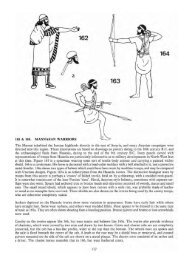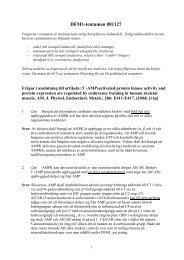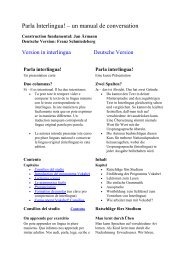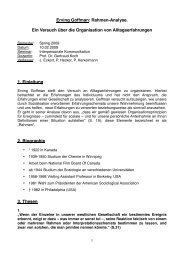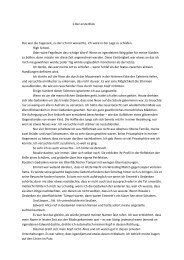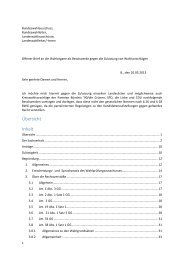lwIP - A Minimal TCP/IP implementation - Wikia
lwIP - A Minimal TCP/IP implementation - Wikia
lwIP - A Minimal TCP/IP implementation - Wikia
You also want an ePaper? Increase the reach of your titles
YUMPU automatically turns print PDFs into web optimized ePapers that Google loves.
14 PERFORMANCE ANALYSIS<br />
UDP<br />
ICMP<br />
<strong>IP</strong><br />
API<br />
<strong>TCP</strong><br />
Support functions<br />
Figure 15. <strong>lw<strong>IP</strong></strong> object code size when compiled for the 6502.<br />
Table 3 shows the sizes of the object code when compiled for the 6502 and in Figure 14 the<br />
relative sizes are shown. We see that the <strong>TCP</strong>, the API, and the support functions are nearly<br />
twice as large as when compiled for the Intel x86, whereas <strong>IP</strong>, UDP and ICMP are approximately<br />
the same size. We also see that the support functions category is larger than the API, contrary<br />
to Table 2. The difference in size between the API and the support functions category is small<br />
though.<br />
The reason for the increase in size of the <strong>TCP</strong> module is that the 6502 does not natively<br />
support 32-bit integers. Therefore, each 32-bit operation is expanded by the compiler into many<br />
lines of assembler code. <strong>TCP</strong> sequence numbers are 32-bit integers and the <strong>TCP</strong> module performs<br />
numerous sequence number computations.<br />
The size of the <strong>TCP</strong> code can be compared to the size of <strong>TCP</strong> in other <strong>TCP</strong>/<strong>IP</strong> stacks, such<br />
as the popular BSD <strong>TCP</strong>/<strong>IP</strong> stack for FreeBSD 4.1 and the independently derived <strong>TCP</strong>/<strong>IP</strong> stack<br />
for Linux 2.2.10. Both are compiled for the Intel x86 with gcc and compiler optimizations turned<br />
on. The size of the <strong>TCP</strong> <strong>implementation</strong> in <strong>lw<strong>IP</strong></strong> is almost 6600 bytes. The object code size<br />
of the <strong>TCP</strong> <strong>implementation</strong> in FreeBSD 4.1 is roughly 27000 bytes, which is four times as large<br />
as in <strong>lw<strong>IP</strong></strong>. In Linux 2.2.10, the object code size of the <strong>TCP</strong> <strong>implementation</strong> is even larger and<br />
consists of 39000 bytes, roughly six times as much as in <strong>lw<strong>IP</strong></strong>. The large difference in code size<br />
between <strong>lw<strong>IP</strong></strong> and the two other <strong>implementation</strong>s arise from the fact that both the FreeBSD and<br />
the Linux <strong>implementation</strong>s contain more <strong>TCP</strong> features such as SACK [MMFR96] as well as parts<br />
of the <strong>implementation</strong> of the BSD socket API.<br />
The reason for not comparing the sizes of the <strong>implementation</strong> of <strong>IP</strong> is that there is vastly<br />
more features in the <strong>IP</strong> <strong>implementation</strong>s of FreeBSD and Linux. For instance, both FreeBSD<br />
and Linux includes support for firewalling and tunneling in their <strong>IP</strong> <strong>implementation</strong>s. Also, those<br />
<strong>implementation</strong>s support dynamic routing tables, which is not implemented in <strong>lw<strong>IP</strong></strong>.<br />
The <strong>lw<strong>IP</strong></strong> API constitutes roughly one sixth of the size of <strong>lw<strong>IP</strong></strong>. Since <strong>lw<strong>IP</strong></strong> can be used<br />
without inclusion of the API, this part can be left out when deploying <strong>lw<strong>IP</strong></strong> in a system with very<br />
little code memory.<br />
14 Performance analysis<br />
The performance of <strong>lw<strong>IP</strong></strong> in terms of RAM usage or code efficiency have not been formally tested<br />
in this thesis, and this has been noted in future work. Simple tests have been conducted, however,<br />
and these have shown that <strong>lw<strong>IP</strong></strong> running a simple HTTP/1.0 server is able to serve at least 10<br />
simultaneous requests for web pages while consuming less than 4 kilobytes of RAM. In those tests,<br />
only the memory used by the protocols, buffering system, and the application program has been<br />
taken into account. Thus memory used by a device driver would add to the above figure.<br />
20





